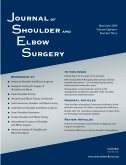
Shoulder & Elbow
Tenodesis vs. tenotomy for LHBT lesions with concomitant rotator cuff tears
J Shoulder Elbow Surg. 2016 Jul;25(7):1107-14137 patients with lesions in the long head of the biceps tendon (LHBT) and small- to medium-sized rotator cuff tears were randomized to undergo either tenotomy or tenodesis. The purpose of the study was to compare the clinical and radiographic outcomes between the two treatments. Outcomes included the American Shoulder and Elbow Surgeons Score, simple shoulder test, visual analogue scale pain scores, range of motion, cosmetic changes, elbow motor power, and magnetic resonance imaging, measured to a minimum of 12 months postoperatively. Findings indicated no significant differences between treatment groups for range of motion, or pain and functional scores. Elbow motor power in supination was significantly greater in the tenodesis group compared to the tenotomy group, but flexion and pronation were similar. Additionally, the tenodesis group had a lower incidence of Popeye deformity compared to the tenotomy group (5.6% vs. 19.6%).
Unlock the full article
Get unlimited access to OrthoEvidence with a free trial
Start TrialCritical appraisals of the latest, high-impact randomized controlled trials and systematic reviews in orthopaedics
Access to OrthoEvidence podcast content, including collaborations with the Journal of Bone and Joint Surgery, interviews with internationally recognized surgeons, and roundtable discussions on orthopaedic news and topics
Subscription to The Pulse, a twice-weekly evidence-based newsletter designed to help you make better clinical decisions
Exclusive access to original content articles, including in-house systematic reviews, and articles on health research methods and hot orthopaedic topics
Or continue reading this full article
Register Now

Subscribe to "The Pulse"
Evidence-Based Orthopaedics direct to your inbox.




































